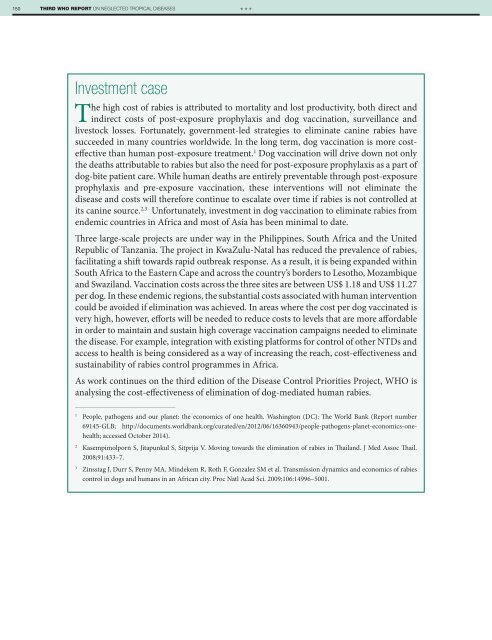1A9bnbK
1A9bnbK
1A9bnbK
You also want an ePaper? Increase the reach of your titles
YUMPU automatically turns print PDFs into web optimized ePapers that Google loves.
150 THIRD WHO REPORT ON NEGLECTED TROPICAL DISEASES<br />
***<br />
Investment case<br />
The high cost of rabies is attributed to mortality and lost productivity, both direct and<br />
indirect costs of post-exposure prophylaxis and dog vaccination, surveillance and<br />
livestock losses. Fortunately, government-led strategies to eliminate canine rabies have<br />
succeeded in many countries worldwide. In the long term, dog vaccination is more costeffective<br />
than human post-exposure treatment. 1 Dog vaccination will drive down not only<br />
the deaths attributable to rabies but also the need for post-exposure prophylaxis as a part of<br />
dog-bite patient care. While human deaths are entirely preventable through post-exposure<br />
prophylaxis and pre-exposure vaccination, these interventions will not eliminate the<br />
disease and costs will therefore continue to escalate over time if rabies is not controlled at<br />
its canine source. 2,3 Unfortunately, investment in dog vaccination to eliminate rabies from<br />
endemic countries in Africa and most of Asia has been minimal to date.<br />
Three large-scale projects are under way in the Philippines, South Africa and the United<br />
Republic of Tanzania. The project in KwaZulu-Natal has reduced the prevalence of rabies,<br />
facilitating a shift towards rapid outbreak response. As a result, it is being expanded within<br />
South Africa to the Eastern Cape and across the country’s borders to Lesotho, Mozambique<br />
and Swaziland. Vaccination costs across the three sites are between US$ 1.18 and US$ 11.27<br />
per dog. In these endemic regions, the substantial costs associated with human intervention<br />
could be avoided if elimination was achieved. In areas where the cost per dog vaccinated is<br />
very high, however, efforts will be needed to reduce costs to levels that are more affordable<br />
in order to maintain and sustain high coverage vaccination campaigns needed to eliminate<br />
the disease. For example, integration with existing platforms for control of other NTDs and<br />
access to health is being considered as a way of increasing the reach, cost-effectiveness and<br />
sustainability of rabies control programmes in Africa.<br />
As work continues on the third edition of the Disease Control Priorities Project, WHO is<br />
analysing the cost-effectiveness of elimination of dog-mediated human rabies.<br />
_____________________<br />
1<br />
People, pathogens and our planet: the economics of one health. Washington (DC): The World Bank (Report number<br />
69145-GLB; http://documents.worldbank.org/curated/en/2012/06/16360943/people-pathogens-planet-economics-onehealth;<br />
accessed October 2014).<br />
2<br />
Kasempimolporn S, Jitapunkul S, Sitprija V. Moving towards the elimination of rabies in Thailand. J Med Assoc Thail.<br />
2008;91:433–7.<br />
3<br />
Zinsstag J, Durr S, Penny MA, Mindekem R, Roth F, Gonzalez SM et al. Transmission dynamics and economics of rabies<br />
control in dogs and humans in an African city. Proc Natl Acad Sci. 2009;106:14996–5001.


